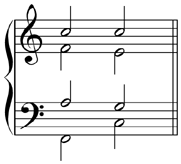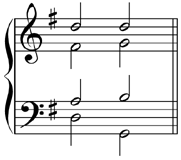Cadence Points
How to use different types of cadences
Cadences in music are broadly equivalent to the ends of lines of poetry, and different types of cadence provide different senses of "this is the end", or "but wait, there's more" to phrases of music.
More specifically, a cadence is just the final two chords in a phrase of music, and the different types of cadence ("perfect", "imperfect" and "plagal") are distinguished by which chords these are (tonic, dominant, etc).
To identify a cadence, therefore, you first need to be able to identify the two chords by reducing them to triads. In addition, it's essential to know the key of the music before being able to correctly name triads, and then the cadence.
We have looked at identifying chords and triads in a previous tip, so here's some advice on identifying cadences from triads. First of all, you must learn the three basic types of cadence:
- Imperfect cadence: x- V
(anything-to-dominant, e.g. IV-V, ii-V, I-V; sounds like: "but wait, there's more!") - Plagal cadence: IV - I
(subdominant to tonic) - Perfect cadence: V - I
(dominant to tonic, sounds like: "this is the end.")
The Roman numerals in the list above refer to the degrees of the scale on which each triad is formed: for example, IV means a triad formed on the IVth (or 4th) degree of the scale, the subdominant. We can therefore see immediately why we need to know the key, otherwise we don't know to which scale we are referring!
An Example
Look at this cadence in four-part harmony:
 |
You should be able to quickly reduce these two chords to two triads: F-A-C and C-E-G. These are major chords and they are both in root position. But what's the cadence?
If you don't know the key, you are in trouble: the triad C-E-G could be the tonic (I) in C major, in which case this is a plagal cadence (IV-I). But if the key is F major, then the triad F-A-C is the tonic, and this is an imperfect cadence (I-V).
If you have not been told the key, the surrounding music and the key signature should give you a clue. In this example, the key signature is that of C major (no sharps or flats, unlike F major which has one flat), and we can accurately describe the cadence as a plagal cadence in C major.
This example shows why the plagal cadence does not always provide a very strong sense of "this is the end" to a phrase: if the key is not obvious, the listener might not know whether this is a plagal cadence ending on the tonic (meaning: "this is the end") or an imperfect cadence ending on the dominant (which says, "but wait, there's more!").
A perfect cadence, on the other hand, clearly says "this is the end", because it cannot be interpreted as a cadence ending on V. Think of the ending to a big symphony: Beethoven, for example, usually finishes on a lengthy succession of perfect cadences. He's trying to tell you, very emphatically, "I've finished! It's the end! Really, it's the end! Time to go home! It's over! End of story! Finished!"
A Question
Look at this cadence:
 |
You should be able to reduce these two chords to the triads D-F#-A and G-B-D. If the second chord were V, then the key would be C major and the F sharp in the first chord would be a very "wrong" note.
So can you answer this:
Q. What kind of cadence do you think this is? Perfect, imperfect, or plagal, and in which key?
Answer: Perfect cadence, G major
The key signature has one sharp, so the key could be G major (or E minor). The chords match triads of V and I in G major, so it is a perfect cadence in the key of G major.
The next Clements Tip will be with you soon — keep an eye on your inbox!
Not a subscriber? Get your FREE 40-part email course here
Did you like this tip?
You'll find lots more on the Clements Theory website:
- 80 step-by-step study guides from the basics to Grade 5 and beyond
- Revision questions to test your comprehension of each guide
- Over 7000 practice questions organised by difficulty and topic
- The Clements Q&A — rapid assistance from a music theory expert!
- Track your progress with the clever Clements Theory tools: see instantly where you are improving and where you need to practice more
Clements Theory is perfect for anyone studying for Associated Board or Trinity College Theory of Music Exams (Grades 1 to 5), and for GCSE or A Level Music.
“I've finished my theory exam and passed with Distinction,
thanks so much for your help!! ”
— Carmen Guthrie
Clements Theory user and successful Grade 5 Theory candidate
“Thank You, I have passed my theory exam,
I found Clements Theory very helpful!”
— Stephanie Hunter
Clements Theory user and successful Grade 5 Theory candidate